#Construction Drawing Software
Explore tagged Tumblr posts
Text
Revolutionizing Construction Projects: The Power of Drawing Management Software
Revolutionizing Construction Projects: The Power of Drawing Management Software
Construction drawing management software is essential for Architects, Construction Managers, and Contractors to organize, track, and share plans across multiple building phases. Construction drawing management done right ensures accuracy, efficiency, and collaboration between teams to reduce errors, streamline communication, and improve project timelines.

Introduction.
Construction drawing management relates to a coordinated handling of plans for the entire project lifecycle. It incorporates organization, storage, retrieval, and distribution of architectural, structural, and MEP drawings to ensure communication and collaboration between project participants. Use of customized construction drawing management software improves document control, file versioning, annotation and markup, and revision tracking. Centralized access to accurate and updated drawings augments efficiency, lowers errors, improves team coordination, and fosters successful project execution within planned budget and schedules.
Importance of efficient construction drawing management in construction projects.
Effective construction drawing management with construction drawing software is paramount to ensure accuracy, collaboration, and quick project execution. It simplifies communication between project participants, reduces errors, expedites decision-making, and improves coordination. Organized and centralized drawings optimize workflow, increase productivity, and contribute to high-quality project outcomes.
Overview of the article's focus on the transformative power of construction drawing management software.
Drawing management software enhances construction projects by organizing, centralizing, and streamlining drawings. It improves accuracy, collaboration, and efficiency leading to refined workflows, faster decision-making, and positive project outcomes.
The Challenges of Traditional Construction Drawing Management.
Traditional construction drawing management raises various roadblocks that include manual updates, version control issues, revision tracking problems, and limited file access. These obstacles lead to ambiguities, errors, and delays impeding the collaboration and efficiency within construction projects.
Inefficiencies in manual processes :
Traditional construction drawing management software depends on manual processes that lead to discrepancies in version control, time-consuming updates, and file tracking issues. These challenges result in errors, delays, and misperceptions leading to collaboration issues between project participants. Manual processes lack accuracy and agility to keep projects within budget and on schedule emphasizing the need for automated and structured construction drawing management solutions.
Risks of errors and miscommunications :
Legacy drawing management techniques lead to significant challenges that create errors and confusion. Limited drawing accessibility while relying on paper-based copies stored in cabinets or unplanned shared drives with restricted access pose risks of miscommunication and errors. Additionally, manual processes are prone to inefficiencies and delays that consume resources and time. Furthermore, coordinating changes amongst project participants becomes complex and time-consuming that impacts budgets and timelines.
Time and resource constraints :
In addition to miscommunication and errors, traditional drawing management leads to resource and time constraints based on several factors. Manual processes like printing, distribution, and physical storage of drawings are time consuming and require multiple resources. Coordinating changes and updates between stakeholders through manual processes leads to issues in decision-making and implementation that impacts project timelines. Retrieval of specific drawings from unorganized digital folders is time-consuming and hinders efficiency and productivity. These challenges highlight the need to deploy construction drawing management software that reduces time and resources in construction projects.
Understanding Construction Drawing Management Software
Construction drawing management software simplifies organization, storage, and distribution of construction drawings that is significant for effective construction execution. It centralizes drawing access and facilitates collaboration between stakeholders to reduce errors. Its features include version control, markup tools, and document tracking to ensure accuracy and clarity for the entire project lifecycle. Digitized workflows and process automation saves time and resources spent on manual tasks. It improves communication with real-time updates and seamless information sharing between various teams. Ultimately, construction drawing management software is crucial to optimizing efficiency, lowering risks, and producing successful project results.
How Drawing Management Software Enhances Efficiency
Centralized storage and accessibility of drawings
Collaboration and communication tools
Version control and revision tracking
Integration with other project management tools
Cost and time savings for construction projects
Addressing Common Concerns and Implementation Challenges
Security and data integrity
Training and adoption by project teams
Compatibility with existing workflows and systems
Strategies for successful implementation and overcoming resistance to change
The Future of Construction Drawing Management
The future of construction drawing software is set for transformation through Artificial Intelligence - AI and Machine Learning – ML. AI algorithms will change document management through task automation using drawing recognition, quality control, and change detection. ML capabilities enhance predictive analytics, risk forecasting, and workflow optimization. These technologies improve collaboration, streamline processes, and enhance decision-making. Additionally, AI-driven insights drive innovation allowing adaptive and responsive project management. Ultimately, construction drawing management software reinforced by AI and ML will build a new era of accuracy, innovation, and efficiency within the AEC industry.
Conclusion
In conclusion, the use of construction drawing management software will create a radical change in project management, driving construction projects towards extraordinary project success. Centralized document management will enhance collaboration and advanced tools like AI and ML will streamline workflows, reduce risks, and foster innovation. It will empower teams to work smarter, make informed decisions, and handover projects within budget and time. As the construction industry continues to embrace digital evolution, the power of advanced construction drawing management software will become evident setting new standards of accuracy and efficiency within the built environment.
Visit : www.ifieldsmart.com/construction-drawing-management-software
#Construction drawing management software#2D construction drawing management software#Construction drawing software#Construction drawing management#2D Construction drawing Software#3D Construction drawing Software#Construction drawing Software#Construction drawing#drawing software#Civil#civil engineering#civil industry#construction management software#architects#architectural design#architectdesign#building technology
0 notes
Text

Some more concept designs but this time for two guys I’ve never talked abt before oops
#keese draws#rain world#rain world oc#iterator oc#rw iterator#rain world iterator#these two are still mostly in the brainstorming phase but I do enjoy them#they share a structure and are also the worst <3#and by that I mean after the mass ascension they eventually start doing some mafia shit#synch started developing ways to carry out construction and repairs and such to the twos structure along with some renovations#the big one being to join the twos chambers so they can actually physically interact#and this gave light some ideas of ways to make sure the two would have access to enough resources to thrive long term#so they and synch worked together to develop different ways of transporting goods and supplies long distance mostly through organisms#and eventually as their fellow iterators began to slowly break down light started offering synch’s services to them#they’d use the chance to get all sorts of data scraping software into other iterators along with all sorts of other shit#and they’d use their newfound leverage over these iterators to blackmail them into giving up their resources for them and synch#often times at the threat of direct structural sabotage that they would follow up on if the iterator didn’t comply#synch is vaguely aware of the stuff that light is doing but doesn’t rly care that much since she rarely talks to other iterators#synch just wants light to be happy and would let her get away with pretty much anything
5 notes
·
View notes
Text
The Power of As-Built Drawings Software: Streamlining Construction with iFieldSmart Technologies
As-Built drawings, which meticulously document the final state of a construction project, are indispensable for facility management, maintenance, renovations, and future projects. Traditionally, creating and managing these drawings was a laborious manual process, fraught with errors and inefficiencies. However, the advent of As-Built drawings software has revolutionized this aspect of construction, leading to significant time and cost savings while improving accuracy.

Challenges Without As-Built Drawings Software:
Inaccurate or incomplete documentation: Hand-drawn or paper-based As-Builts are prone to errors and may miss critical details.
Time-consuming updates: Making changes or revisions can be arduous and delay project completion.
Difficulty sharing information: Collaboration and communication between stakeholders can be hindered.
Risk of losing information: Physical drawings can be lost or damaged.
Lack of version control: Tracking changes and maintaining a historical record can be challenging.
.
iFieldSmart Technologies: A Leader in As-Built Solutions:
iFieldSmart Technologies has emerged as a leading provider of innovative As-Built drawing software. Their cloud-based platform streamlines the creation, management, and sharing of As-Built documentation.
.
Key Benefits of iFieldSmart's As-Built Software:
Accurate and detailed drawings: The software facilitates the creation of precise drawings, capturing all essential modifications and additions made during construction.
Real-time updates: Changes can be easily made and synchronized across all relevant parties, ensuring everyone has access to the latest information.
Improved collaboration: The platform enables seamless collaboration between architects, engineers, contractors, and owners, fostering efficient communication and decision-making.
Enhanced data security: Cloud storage ensures data protection and minimizes the risk of losing critical information.
Comprehensive version control: The software tracks changes and maintains a detailed history of revisions for better accountability.
Mobile accessibility: Field teams can access and update As-Builts on their mobile devices, promoting efficiency and accuracy.
.
Capabilities of iFieldSmart Technologies' Software:
Markups and annotations: Easily add notes, measurements, and other relevant information to drawings.
Photo and video integration: Incorporate visual documentation directly into the As-Built drawings.
3D model integration: Seamlessly link As-Built drawings with 3D models for a more comprehensive understanding of the project.
Customizable reporting: Generate reports tailored to specific project requirements.
Integration with other construction management tools: Streamline workflows and data sharing with other software applications.
.
The Future of As-Built Software: AI and ML Integration:
The future of As-Built software is being shaped by artificial intelligence (AI) and machine learning (ML). iFieldSmart Technologies is at the forefront of these advancements, exploring how AI and ML can further automate the creation and updating of As-Built documentation. Imagine AI algorithms that can automatically detect changes in construction plans, generate As-Builts based on site photos, or even predict potential maintenance issues based on historical data. These capabilities will further streamline construction processes, reduce errors, and provide valuable insights for facility management.
.
10 Frequently Asked Questions About As-Built Drawings Software
1. What are As-Built drawings?
Detailed drawings that show the final state of a construction project, including all modifications made during construction.
2. Why are As-Built drawings important?
They're essential for facility management, maintenance, renovations, and future projects.
3. How does As-Built software work?
It allows users to create, manage, and share As-Built drawings electronically, improving accuracy and efficiency.
4. What are the benefits of using As-Built software?
Improved accuracy, real-time updates, enhanced collaboration, data security, and comprehensive version control.
5. Is As-Built software suitable for all types of construction projects?
Yes, it can be used for residential, commercial, industrial, and infrastructure projects.
6. Can As-Built software integrate with other construction management tools?
Yes, many As-Built software platforms offer integration with other tools like project management and BIM software.
7. How do AI and ML impact the future of As-Built software?
AI and ML can automate the creation and updating of As-Built drawings, leading to further efficiency and accuracy improvements.
8. Is iFieldSmart Technologies a reliable provider of As-Built software?
Yes, iFieldSmart Technologies is a leading provider with a strong track record and innovative solutions.
9. How can I get started with iFieldSmart Technologies' As-Built software?
You can contact them through their website or request a demo to learn more.
10. What is the pricing structure for iFieldSmart Technologies' As-Built software?
You'll need to contact them directly for pricing information, as it may vary based on your specific needs.
.
Conclusion :
As-Built drawings software, with innovative solutions like those offered by iFieldSmart Technologies, is transforming the construction industry. By embracing this technology, construction professionals can improve accuracy, streamline workflows, enhance collaboration, and unlock new possibilities for facility management and maintenance. As AI and ML continue to advance, the future of As-Built drawings software looks brighter than ever, promising even greater efficiency and insights for construction projects worldwide.
Visit : www.ifieldsmart.com/as-built-drawings
#As-Built Documentation#As-Built Drawings#As-Built Drawings Software#civil engineering#construction#construction software
0 notes
Text
Presentation giving up a brief of what isdrafting in construction, its importance, types of drafting, the working process, collaborative approach and the future of drafting.
#drafting in construction#technical drawings#blueprint in construction#architectural drawings#structural drawings#MEP drawings#civil drawings#shop drawings#drafting tools#drafting software#CAD software#digital drafting#drafting process
0 notes
Text
Structural Engineering Projects with BIM-Integrated Precast Concrete Design
Discover the future of construction with BIM-Integrated Precast Concrete Design! This innovative approach revolutionizes how we plan and execute structural engineering projects. By integrating Building Information Modeling (BIM) with precast concrete, we achieve unparalleled precision, efficiency, and sustainability. Say goodbye to traditional methods and embrace a smarter, more streamlined process that saves time and reduces costs.
Join the movement towards modern construction excellence! BIM-Integrated Precast Concrete Design not only enhances collaboration among project stakeholders but also ensures higher quality and consistency in every build. From concept to completion, experience the benefits of cutting-edge technology in your structural engineering projects. Let's build the future together! 🏗️✨

#precast CAD drawings#precast concrete design#precast concrete design workflow#precast constructions using BIM software#precast engineering design
0 notes
Text
Idk who needs to hear it but if you have Aphantasia you can absolutely do character art. Don't let it discourage you. Especially since a good portion of art advice won't fit you and will leave you feeling like its your fault.
I have Aphantasia, its super hard to put characters in poses from my mind. I cannot draw cartoons or exaggeration well, its very hard because I do not see the drawing until it is on the page. I use so many construction lines and blocks of color and always need a reference to base my character poses on. I cannot imagine things artistically before they're on the page and it is super frustrating.
You can still do it with Aphantasia though, it just takes practice. So many of your sketches without references are going to look awful despite you knowing the proper proportions of the human body, it doesn't mean you don't know what you're doing.
It just means you need to give yourself extra help. You're not lesser or bad for not being able to draw on a whim or not having these intricate details. Trust me, I've struggled with thinking that.
The best thing you can do to work with it is collect so many references, use a pose software (like magic poser), and absolutely screenshot and collect art that has a creative element you struggle with. (For me its color, backgrounds, and splash text.) Also, maybe practice abstract art. You have a brain unhindered by a visual expectation, I recommend it. For me I like to do surrealist/abstract pictures of water and space. It takes technical skill but everyday is a good day to start practicing.
Having Aphantasia is a neutral thing. It's not bad or good, it's just there. That bad part is not acknowledging that you work differently so you need to adapt differently.
6K notes
·
View notes
Text
Which Education🎓📚 is right for you?
Mercury rules your interest and consequently which type of course you would select.
Now you have to see how Mercury is placed. For example if Mercury is conjunct Moon it would have same effect as Mercury in Cancer or Moon opposite Mercury.
Mercury -Sun: It is called Budh Aditya yoga. These people can shine in political science, geology, sociology, medicine and they can be good leaders too. They may prepare for competitive exams.
Mercury-Moon: Some changes or confusion in choice of course. Can study more than one subject but both vastly different from each other. Chemical, hotel management, nutrition, chef, psychology, tarot and intuitive studies.
Mercury-Mars: Some obstacles in education, breaks and interruptions (dropping classes), engineering (especially related to machines, drawings, plans, civil, electronics), medicine (especially related to surgery), fire and safety engineering,
Mercury-Venus: Sales, marketing, HR, interior designing, makeup courses, all type of fine arts, vocational courses, acting courses.
Mercury-Saturn: Engineering (like construction , petroleum, mining core subjects), structural engineering, drafting, administrative studies.
Mercury-Jupiter: Finance, CPA, CMA, accounting, teaching, law field, journalism, VJ, pilots, aeronautical.
Mercury- Rahu: Chemical, nuclear subjects, cinematography, software courses, digital marketing, share markets, computer hardware, import export, AI, Machine Learning courses.
Mercury-Ketu: Computer coding, electrical engineering, bio technology, astrology, virology, research oriented fields.
For Readings DM
#astrology#astrology observations#zodiac#zodiac signs#astro community#astro observations#vedic astrology#astro notes#vedic astro notes#astrology community#mercury signs#mercury in aquarius#mercury retrograde#pisces mercury
845 notes
·
View notes
Note
tmnt 2012 donnie x gn!reader who's an aspiring fashion designer headcanons pretty please? :DD
Hello, hello! Uuuugh, i love TMNT 2012 Donnie. That gap between his teeth is just adorable! Anyways, hope you like it ~ ♡♡♡♡

Fashion Designer, Baby! *.✧

Donnie absolutely admires your creativity
The moment you told him you were into fashion design, his mind started spinning with ideas on how your talents could align with his love for invention
He’s so fascinated by your process.
If you’re sketching a design, he’ll sit nearby, quietly observing as your pencil flows across the page
Sometimes, he’ll even offer suggestions. “What if you made it glow? I could rig some LEDs into the fabric!”
If you ever work with fabric or patterns in the lair, Donnie insists on giving you a proper workspace
He repurposes a corner of his lab, setting up a table with extra lighting and storage for your supplies
He’s genuinely impressed by how detail-oriented you are, and he can relate to that because of how meticulous he is with his own projects
It makes him feel closer to you
Donnie will happily share his tech to make your work easier
Need a precise measurement? He’s got a gadget for that. Want to try designing something digitally? He’ll program a fashion design software for you
He loves watching you sew or work on your designs
Sometimes, he’ll ask questions like, “How do you know what fabric works best?” or “What inspired this color combo?”
If you ever make something for him—like a scarf to fit his unique frame—he’s stunned
He’ll wear it proudly around the lair, showing it off to his brothers. “Y/N made this for me. Cool, right?”
Donnie is surprisingly good at giving feedback
He’ll offer constructive criticism in the gentlest way possible, always making sure you feel encouraged
When you hit creative blocks, he’s there to help brainstorm
He’ll pull out his sketchpad and start doodling ideas with you
Some of his concepts are hilariously impractical, but it makes you laugh
If you’re ever working late into the night, Donnie will stay up with you
He’ll bring snacks, tinker with his gadgets nearby, and remind you to take breaks when you start to get too focused
He secretly loves how passionate you are about fashion
It inspires him to put even more heart into his own projects
Sometimes, he’ll surprise you with a “challenge,” like, “Can you design something inspired by the stars?” or “What about a stealth outfit for April?”
He’s always eager to see how you’ll tackle it
The first time you invite him to a showcase or event where your designs are featured, Donnie is nervous but incredibly proud
He’ll stay in the shadows to avoid drawing attention but makes sure to support you however he can
Donnie thinks your creativity and talent are beautiful. To him, you’re not just designing clothes—you’re creating art, and he’s completely in awe of you.
88 notes
·
View notes
Text
Morning Star Mod Applications are Open!

Morning Star Zine is looking for moderators! If you're interested in helping produce a MCYT fanzine celebrating Minecraft creators of marginalised gender identity or experience, consider applying using the form linked below.
> FORM LINK <
We are specifically looking to fill the following positions:
Editing Mod: Layout experience in a suitable software (Indesign, for example) & capable of assembling all the zine elements into the end result.
Art mod: ability to give constructive criticism and help contributors with their piece, ability to create art pieces for the zine (for example, promo art, spot illustrations within the zine, etc.)
Writing mod: ability to give constructive criticism and help contributors with their piece, ability to write for the zine (for example, social media posts, foreword& conclusion, …)
Finance Mod: Experience with print on demand, order fulfillment and/or physical zine distribution. (Added disclaimer that we aren't sure yet if we will do a physical print of the zine as well, so taking on a finance mod isn't guaranteed)
We are also very interested in having members who are knowledgeable about different CCs and sides of MCYT than the current mod team is, such as QSMP, DSMP, standalone streamers/youtubers... As it stand, mods are mostly familiar with Hermitcraft and the Life series.
The form will close on March 17th at Noon GMT; the applications results will be sent out sometime during the following week.
FAQ · MOD INTROS · TWITTER
[ID: A stylised drawing of IvoryCello from the torso up, holding a sword and wearing knight's armor. She is overlayed onto glowing constellation of stars, against a dark sky background. Text shaded like gold reads ‘Morning Star’ and below, in a bigger size, ‘Moderator Applications Open Now' End ID.]
#mcyt#mcyt fandom zine#mcyt fanzine#fanzine#ivorycello#ivorycello fanart#hermitcraft#qsmp#dsmp#empires smp#pirates smp
82 notes
·
View notes
Text
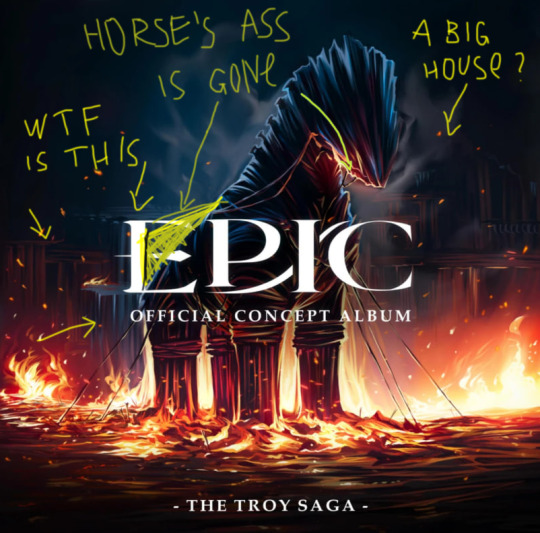
We've got some new cover art and as someone who works in digital media and deals with AI content on daily basis this new cover for Troy Saga set off an alarm in my brain. Naturally I sank into an analyzing spiral, because that's just how my brain works.
"Looks like an AI art with repaints on top" I thought to myself, but to be sure I've checked it with different AI recognizing software (remember kids, if you use AI to generate your art, other AI can reverse engineer the process and identify it!). But so can a human eye most of the time. Pay attention to the combination of these identificators:
- weird blur
- different lines of horizon in one image
- bonkers anatomy/construction errors
- high contrast
- a lot of nonsense happening in the background
The results of AI checkup on the new Troy cover art were mixed

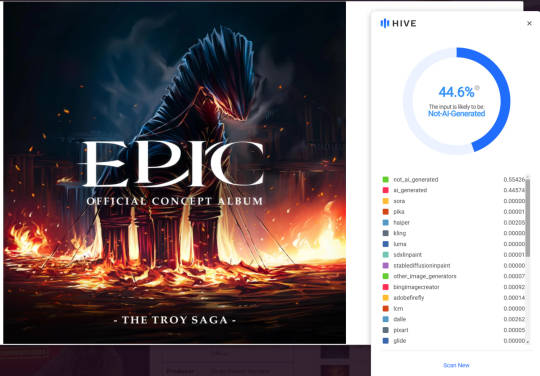
"Okay, let's check out the original Troy Saga cover, I like this one"
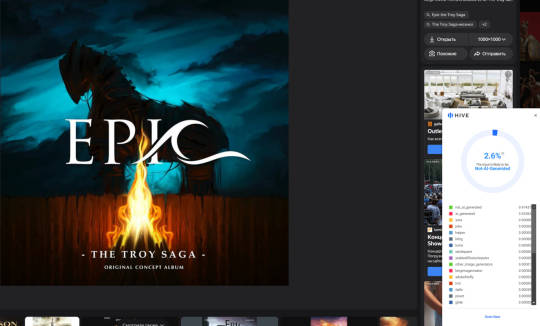
Yep, it has no out of place blur, the wooden horse's anatomy doesn't weird me out, the backgrounds look nice, deliberately painted with attention and care, I can make sense of the individual strokes. Good to know that my eyes are still good for something.
"Just to be sure, let's check out the Cyclop's Saga"

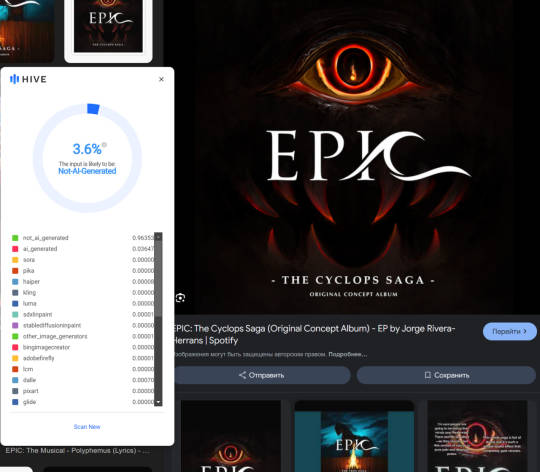
Okay, now it's proper weird. Maybe the Hive is off caliber? Wait five minutes, let me make a quick AI Thunder Saga cover art.
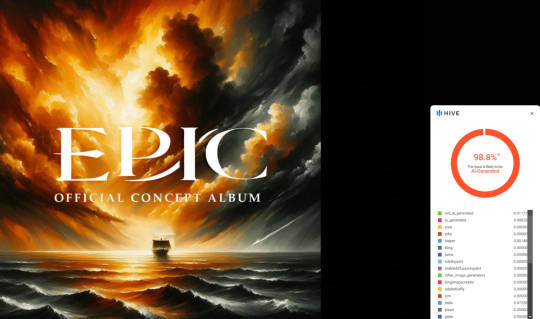
Nope, still works. What about other covers?
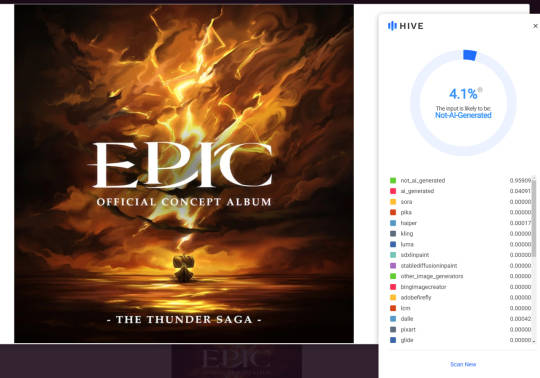
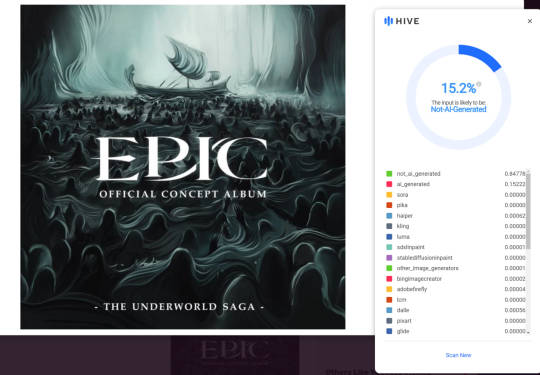
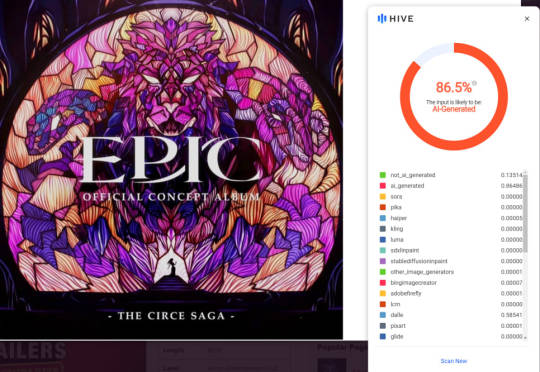
Fascinating! To be honest Circe Saga cover art doesn't look like Ai to me (all three animals are drawn with nice proportions and the lion is probably drawn with the help of Symmetry tool in Procreate, AI is surprisingly shitty at doing perfect symmetry).
Maybe it's the style of the artist that's confusing to the AI detector? Zwist seems to be particularly fond of whirlwind designs in all of her artwork (bad AI art often does weird stripes and whirlwinds, especially when you're trying to generate something which doesn't have a lot of references for it in the dataset that AI is trained on). Let's run Hive on her original artwork with a lot of whirlwinds and a wonky tree.

...okay. Now that is weird.
Look, I'm not saying that Zwist is a bad artist or something, using Ai isn't against the law and she clearly can paint better than I do. She is talented, go show love to her original artworks that are not Epic related. Hell, I can't even prove with 100% certainty that AI was used at all. Just because I don't like the new Troy cover art doesn't mean you shouldn't enjoy it too.
But the whole situation is fascinating to me. A lot of people on insta ask if the new Troy cover is AI, only to be shut down by fans who scream "no, that's just her artsyle and X confirmed that it's not AI, you are just haters".
YOU ARE NOW IN THE UPDATED PART OF THE POST
Special thanks to the people who shared the link to the new Troy Saga cover art speedpaint for erasing my doubts and providing a respectful conversation in the comments.
Watched through the speedpaint a few times, trying to figure why the end image became unsettling enough for a lot of people (myself included) to assume it's AI.
My guess is that Zwist has developed for herself an intricate decorative style, but isn't very familiar with so called 'academic' art.
Why do I think that? Well, I wanted to see how artists of the past depicted the wooden horse, and do you know what image you see when you type up 'Trojan horse' into Google? That's right, it's the giant prop from the movie Troy (2004). And you know, no shame here, using references to draw something you've never seen before is good, I'm just shocked I didn't recognize this design sooner it's very cool. What I really like about it is that it really looks like it's been made rather fast from the scraps of the broken down ships and yet it still resembles an actual horse. Look at the cute pointy ears! Look at the mouth of it! This gorgeous posture!

What's even better, it still exists somewhere in Turkey (well maybe not the actual prop, but the full size replica of it), so there's a ton of photos from different points of view. My best guess is that Zweist used this one as a reference for the new Troy Saga cover:
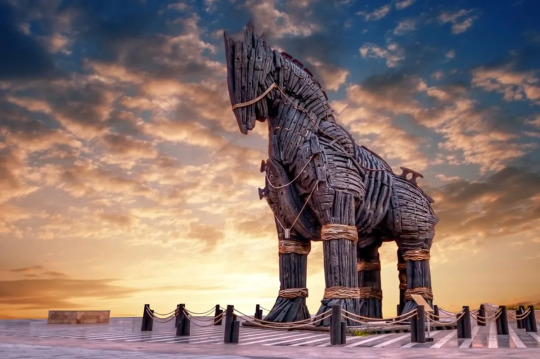
And here's a problem - this is a very complex structure to draw. Not only that, but Zweist also uses two light sources - moonlight from above and the light of the fire below, which means that we have two different sets of shadows emerging from these light sources.
Unlike all other covers that are very decorative in nature, this one is attempted to be very realistic, almost cinematic in its use of lighting. With all that extra complication it's easy to set yourself up for failure and get too much in the details while losing the larger shapes.
Unfortunately in her simplification of the original reference Zweist completely neglects all the intricate shapes and planes that make up the wooden horse. She forgets that wood cannot bend in circles like that, or that unpolished wood is a low-reflective surface (which means that even the lightest spot lit up by the firelight will be darker than the light on the sand/marble/metal coming from the same light source). It seems like she doesn't analyze the shape of it at all, so we lose the majestic posture and the shape of the horse head.
Just for the fun of it I used 1,5 hours of my time to photobash the reference photo into the original Zweist background. It's very rough (I literally painted everything using nothing but a standard Photoshop round brush and a computer mouse), but I think it gets my point across.

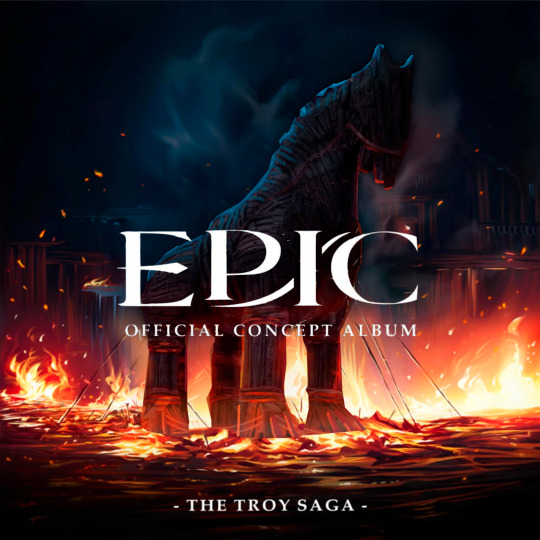
I'm too tired to redo the background and this post is already ridiculously long. But I think that it suffers from the same problems - lack of research and care. Those are just some random shapes taking up space. I get that it's supposedly a burning Troy we see around, but does it look like anything to you? I mean really? Again, it's just a shapeless mess. And all of that could be avoided with a bit of extra research and analysis. There's more to the ancient ruins that the same set of columns over and over.

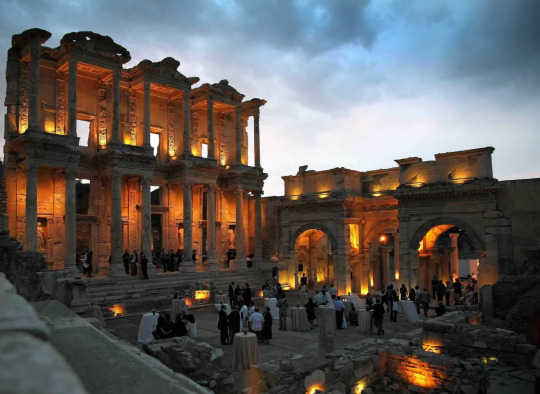
So, what is can we learn from it? What is the conclusion?
Zwist is a talented young artist, but painting "realistically" isn't her strongest suit. You may like her style, or you may not, but I think there is a difference between "doing it your way" and "trying to succeed and failing". She may try to learn from this situation in two ways: 1) work around her stronger sides making the next covers with simpler designs and less intricate lighting or 2) practice the more realistic style and get better at it.
I don't know the exact reasons why the AI recognizing software flagged some of her work as AI generated. But I think that if it's not just your audience who starts to wonder if you used AI, but you somehow manage to confuse the very program that detects AI, then you've got a problem with your art.
If we want to beat AI companies in their game and stay relevant as professional artists we can no longer produce mindless art. We can no longer afford to produce sloppy work. As sad as it is, within next 10 years there is going to be a large shift in understanding and producing art as we know it. If the art we create can be easily replicated by AI or will look like it's been made with AI, then no one would bother to commission art from you. We have to adapt, to find new ways of exploring our creativity, perhaps even to create a new visual language of expressing ourselves.
In the end of a day human art always beats AI art. You know why? Because AI is not really Artificial Intelligence. It's just a very complex algorithm that is good at recognizing patterns. That's all it is. It doesn't have a conscience, it has no context for the human experience, it cannot think, and most importantly - it cannot invent.
So I want to end this post on the hopeful note - the art will survive. The artists will survive. And if we can learn anything from this situation is that kindness and open dialog is the vest way to deal with confusion. Once again I want to thank everyone who was kind enough to comment on and engage with this post. It grew out of love for something that is deep and personal to me (Epic) to a larger discussion of the changes in the world of visual art (something I love and care for even more). Hope this update spawns more nuanced and respectful discussion on the topic!
#epic#epic the musical#I hate this timeline (but slightly less now)#troy saga#thank everyone for sending a link to the speedpaint#read the post if you want to watch me gradually lose my sanity over unimportant stuff I guess#ai art
35 notes
·
View notes
Text
The construction industry is rapidly evolving, and Construction Drawing Management Software is leading the charge. By embracing this digital future, construction companies can build not only structures, but a foundation for success, efficiency, and collaboration on every project.
Visit: www.ifieldsmart.com/construction-drawing-management-software
#construction management software#Construction Drawing Management Software#Construction Drawing Software#Construction Drawing Management#2D Construction Drawing Management Software#2D Construction Drawing Software#3D Construction Drawing Management Software#Construction Drawings#Construction Drawings Software#ifieldmsart#drawing software#architectural design#design#design collaboration software t#drawfee
1 note
·
View note
Photo

A three dimensional map of the 80 closest stars around our sun.
by u/yarche
Celestial Sample gives a simple representation of the 4 closest star with planet(s) within their habitable zone. It also displays the 80 closest star around our own sun. This simplified and yet precise celestial map is only describing the star in a 6 parsec radius aound the sun. In comparison, the Milky Way measures more than 30 000 parsec which stand for less than 0.000015% of the observable universe. Enjoy!
This celestial is a three dimensional map based on the Galactic Coordinate System with the Sun as its center. Each star is displayed regarding its own Galactic Longitudes, Latitude and Distance from the Sun using the Hipparcos Catalogue and the 3rd Gliese Catalogue of Nearby Stars
Galactic Longitudes (G.Long) measures the angular distance eastward along the galactic equator from the galactic center measured here in degrees.
Galactic Latitude (G.Lat) measures the angular distance perpendicular to a plane parallel to the galactic equator, positive to the north, negative to the south, measured here in degree. In the current celestial map, Galatic Latitude has a 2 multiplication coefficient.
The distance from the Sun is measured in Parsec (pc.) which stands for 3.26 light years. At the current speed of the fastest man made object travelling space (Voyager 1 space probe), it would take approximately 50 000 years to travel a Parsec.
The 3d model has been constructed using the Grasshopper plug-in and with Rhinoceros modeling software. The overall drawing has been done with Adobe Illustrator.
More information at www.simplerandomsample.com
319 notes
·
View notes
Text
Demystifying As-Built Documentation: A Comprehensive Guide
As-built documentation is a critical aspect of the construction and engineering industries, serving as a comprehensive record of a project's final state. It encompasses as-built drawings and other pertinent documents that meticulously detail the project's actual condition after completion, including any modifications made during construction.

The Significance of As-Built Documentation:
As-built documentation plays a pivotal role in various stages of a project's lifecycle. It provides invaluable insights for facility management, maintenance, renovations, and future expansions. These documents ensure that all stakeholders have a clear understanding of the project's current state, reducing the risk of errors and delays during subsequent work.
Challenges in Creating As-Built Documentation:
Creating as-built documentation traditionally involved manual processes, which were often time-consuming, prone to errors, and challenging to keep up to date. The sheer volume of information and the complexity of construction projects made it difficult to maintain accurate records.
Benefits of As-Built Drawings Software:

As-built drawings software has revolutionized the way as-built documentation is created and managed. It offers numerous benefits, including:
Improved Accuracy: Digital tools minimize human errors and ensure precise documentation.
Increased Efficiency: Automation streamlines workflows, saving time and resources.
Enhanced Collaboration: Cloud-based solutions facilitate seamless collaboration among stakeholders.
Real-time Updates: Changes can be tracked and documented in real-time.
Data Accessibility: Information is readily available for all authorized personnel.
Top 10 As-Built Drawings Software:
1. Autodesk BIM 360: A comprehensive construction management platform integrating BIM, project management, and field collaboration. It enables real-time data sharing, version control, and issue tracking for as-built documentation. Its cloud-based nature facilitates collaboration among project stakeholders, ensuring everyone is on the same page.
2. Procore: A robust project management software offering document control, quality and safety management, and real-time project insights. It streamlines the as-built process with centralized document storage, versioning, and markups. Its mobile app empowers field teams to capture and share as-built data on the go.
3. PlanGrid: A popular field collaboration tool known for its intuitive interface and seamless integration with other construction software. It allows for easy markup and sharing of as-built drawings, facilitating communication between the field and office. Its offline capabilities ensure uninterrupted access to as-built information even in remote areas.
4. Bluebeam Revu: A versatile PDF editor and collaboration platform extensively used in the construction industry. It offers powerful markup tools, digital signatures, and 3D model integration for as-built documentation. Its customizable toolsets cater to specific workflows, enhancing productivity and accuracy.
5. Aconex: An enterprise-grade document and project management solution for large-scale construction projects. It provides a secure platform for storing, sharing, and reviewing as-built drawings and other project documentation. Its robust workflows ensure compliance with industry standards and regulatory requirements.
6. Fieldwire: A user-friendly field management software designed to improve communication and collaboration on construction sites. It allows for easy access to as-built drawings, task assignment, and progress tracking. Its intuitive interface and real-time updates keep field teams informed and productive.
7. iFieldSmart Technologies: A comprehensive as-built drawings software solution specializing in mobile data capture, cloud-based platform, 3D model integration, document management, and collaboration tools. It empowers construction professionals to efficiently capture, manage, and share as-built data, enhancing project visibility and decision-making.
8. ConstructConnect: A construction data and technology platform offering a wide range of services, including bid management, project leads, and market analysis. Its as-built drawings software integrates with other project management tools, ensuring a seamless flow of information throughout the project lifecycle.
9. Newforma: A project information management (PIM) solution that centralizes all project data, including as-built drawings, RFIs, submittals, and correspondence. Its powerful search capabilities and customizable reports enable efficient access to as-built information, facilitating informed decision-making.
10. Oracle Aconex: A cloud-based construction collaboration platform offering document management, workflow automation, and project controls. Its robust features streamline the as-built process, ensuring accurate and timely documentation. Its integration capabilities enable seamless data exchange with other construction software.
iFieldSmart Technologies: A Powerful Solution for As-Built Drawings:
iFieldSmart Technologies is a leading provider of as-built drawings software. It offers a comprehensive suite of tools that empower construction professionals to efficiently capture, manage, and share as-built data. Its intuitive interface, robust features, and integration capabilities make it a preferred choice for many organizations.
Key Capabilities of iFieldSmart:
Mobile Data Capture: Enables real-time data collection on-site using mobile devices.
Cloud-Based Platform: Facilitates centralized storage and access to data from anywhere.
3D Model Integration: Allows for the seamless integration of as-built data with 3D models.
Document Management: Streamlines the organization and management of as-built documents.
Collaboration Tools: Promotes efficient communication and collaboration among stakeholders.
Top 15 FAQs about As-Built Documentation and Software
1. What is as-built documentation?
- As-built documentation is a comprehensive record of a project's final state, including drawings, specifications, and other relevant documents that reflect any changes or modifications made during construction.
2. Why is as-built documentation important?
- As-built documentation is crucial for facility management, maintenance, renovations, and future expansions. It ensures accurate information about a project's current state, reducing the risk of errors and delays in subsequent work.
3. What are as-built drawings?
- As-built drawings are detailed plans that accurately represent the final constructed condition of a project. They include all modifications made during construction, making them an essential reference for future work.
4. What is as-built drawing software?
- As-built drawings software are digital tools that streamline the creation, management, and sharing of as-built drawings and related documentation. They offer features like data capture, 3D model integration, and collaboration tools.
5. What are the benefits of using as-built drawing software?
- As-built drawings software improves accuracy, increases efficiency, enhances collaboration, enables real-time updates, and ensures data accessibility, ultimately saving time and resources.
6. What are some popular as-built drawings software options?
- Some popular options include Autodesk BIM 360, Procore, PlanGrid, Bluebeam Revu, Aconex, Fieldwire, iFieldSmart Technologies, ConstructConnect, Newforma, and Oracle Aconex.
7. How does as-built drawings software improve accuracy?
- Digital tools minimize human errors and enable precise data capture, ensuring accurate representation of the as-built conditions.
8. How does as-built drawings software enhance collaboration?
- Cloud-based solutions facilitate seamless sharing of as-built data, enabling real-time collaboration and communication among project stakeholders.
9. Can as-built drawings software integrate with 3D models?
- Yes, many as-built drawings software options offer integration capabilities with 3D models, allowing for a more comprehensive understanding of the project's final state.
10. What are the key features to look for in as-built drawings software?
- Key features include mobile data capture, cloud-based platform, 3D model integration, document management, collaboration tools, and customization options to fit specific workflows.
11. How is AI and ML impacting as-built drawings software?
- AI and ML are being integrated to automate data analysis, identify discrepancies, and generate insights, leading to more efficient and accurate as-built documentation processes.
12. What are some challenges in creating as-built documentation?
- Challenges include manual processes, potential for errors, difficulty in keeping information up-to-date, and the complexity of managing large volumes of data.
13. How does as-built drawings software address these challenges?
- As-built drawings software automates processes, minimizes errors, enables real-time updates, and provides centralized data management, overcoming many of the traditional challenges.
14. What is the future of as-built drawing software?
- The future of as-built drawings software lies in further integration with AI and ML, leading to even greater automation, accuracy, and efficiency in creating and managing as-built documentation.
15. Is as-built drawings software suitable for all types of construction projects?
- Yes, as-built drawings software is adaptable to various project types and sizes, offering scalable solutions to meet the specific needs of different construction projects.
Impact of AI and ML on As-Built Drawings Software:
Artificial intelligence (AI) and machine learning (ML) are poised to transform as-built drawings software further. These technologies can automate data analysis, identify discrepancies between design and as-built conditions, and generate insights for proactive decision-making. AI-powered tools can significantly enhance the efficiency and accuracy of as-built documentation processes.
Conclusion:
As-built documentation is an indispensable asset for any construction or engineering project. As-built drawings software has emerged as a vital tool for creating and managing these documents, enabling organizations to improve accuracy, efficiency, and collaboration. With the continuous advancements in AI and ML, the future of as-built drawings software is incredibly promising, offering even greater potential for streamlining workflows and maximizing project outcomes.
Embracing as-built drawings software like iFieldSmart Technologies is a strategic move for organizations seeking to optimize their as-built documentation processes and unlock the full potential of their projects.
Visit : www.ifieldsmart.com/as-built-drawings
#As-built drawings software#as-built#As-Built Documentation#construction#civil#civil engineering#architects#builder
1 note
·
View note
Text
one of these days im going to release my tlm drafting headcanons from my notes app purgatory and that day is Today.
HERE'S HOW I THINK LEGO MOVIE CHARACTERS WOULD PREPARE AND MAKE DRAFTS
...under the cut
Batman
• Fairly good at drawing. Somehow able to draw straight lines without a ruler perfectly fine every single time but otherwise nothing super noteworthy (he does brag about this constantly however)
• Drafts in white and yellow posca pen??? will use white colored pencil for finer detail however, specifically one of those mechanical colored pencils
• Drafts on black paper because he thinks it makes his designs cooler (it doesn't)
• Dimensions in imperial and would be annoyed if you dare even *insinuate* he use metric. no justification here
• Doodles around his drafts, specifically likes to doodle bats and himself because he, once again, thanks it makes his drafts cooler (the bats kinda do)
• Refuses to leave notes on his designs. you either know what to do or you don't
• Does however write his drawing title obnoxiously large
• Used autocad for like a day, hated it, switched to solidworks and never went back
• Buys autodesk licenses for the rest of the masterbuilders. unwillingly, mind you, wyldstyle just knows his credit card information and abuses it
Benny
• Good at drawing exclusively spaceships. big shock i know
• The king of eyeballing a line or an angle and then labelling it however the fuck he wants. proper measurements take time he could spend drafting or making more spaceships, he'll save measuring and straightedges for drafts he deems important enough
• Uses blueprinting paper. there's no practical purpose for this, he just digs it
• Drafts with whatever writing utensil is on hand
• He gets inspired quite often so he usually keeps a drafting notepad on him just in case
• Leaves a *lot* of notes. Most of them are completely unnecessary and are a funny contrast to his haphazard dimensioning
• Pretty dang good at autocad! Usually reserves it for projects that require a lot more collaboration however
• Usually drafts in metric, can dimension in imperial but prefers not to
• 100% sets autocad to the light background like a monster
• Do not give him any 3d modelling software, he might blow up the computer
Emmet
• Either really good or really bad at drawings (obvs leaning towards bad. we remember the break in plans)
• Dimensions in imperial. I cant justify this one he just does. god bless america or something idk
• Owns a couple drafting pencils but rarely uses them, most of the time he drafts in marker or pen much to the chagrin of anyone who needs to read his drafts (or delight if you're unikitty)
• Started learning how to use autocad after taco tuesday and he's actually pretty good at it! he does use an architectural dimstyle for everything though which is particularly annoying when he's quite often not drafting buildings now
• Has labelled and colored layers 👍 enough said
• Uses disgustingly thick lineweights. horrible.
• Rarely if ever 3d models so he's not good at it, he mostly works on things that 2d conveys better anyways
• Although he's not the best drafter of the master builders, his construction background makes him the best at reading drafts, give him a unikitty draft and he can decipher it like it's nothing
Metalbeard
• Probably the best at drafting of the master builders, he's got the age advantage and lots of practice from making ships
• Drafts in pencil, quill, or charcoal depending
• Who needs straightedges or angle stencils when youre basically a pirate cyborg, expect robot like precision
• Doesn't use standard measuring conventions, instead opts to use the dumbest things possible. The Sea cow's units of measurement were seagulls. It isnt that he cant do normal units of measurement, he just prefers his made up ones
• Makes his drafting paper by himself
• Pretty good with 2d and 3d modelling surprisingly. He doesn't like either, however, he much prefers drafting on paper
• Leaves an average amount of notes on his drafts but has the most disgustingly fancy cursive and writes in his piratey english. Often a nightmare to read if you aren't used to his writing
• Will sometimes do blueprint swaps with Benny wherein they critique each other's work. not sure when they started doing it, but it's become a weekly activity for them
Unikitty
• Worst drafter of the main masterbuilder crew. Most people think it's because she's a cat but no she just doesnt take drafting seriously in the slightest
• Drafts like she's making an arts and crafts project. She has put several bottles of glitter on singular drafts and she will do it again
• Dimensions in rainbows, no knows what this means other than emmet
• Gives the longest, most complicated titles possible
• No such thing as straight lines
• Is entirely capable of drafting properly, just refuses to
• Leaves notes that are entirely unrelated to the draft. she wont tell you how youre supposed to connect two objects but she *will* tell you about the sandwich she ate while making the draft
• Doesnt use autocad, looks too boring
• Didnt use any 3d modelling softwares until she realized you can change the appearance of materials. that was a game changer. still much prefers drafting on paper though
• Likes drafting with emmet sometimes since he seems to be the only person who understands her drawings. to this day no one understands how he does it
Vitruvius
• Going blind has, surprisingly, not made him much worse at drafting, just changed his process a bit
• Drafts in pencil
• Probably the person who least frequently drafts of the main masterbuilders. On account of just not needing to and also on account of being dead
• Dimensions in the old anglo-saxon units of measurement
• Doesn't title his drafts and doesnt see a point in doing so
• Leaves the most vague, utterly confusing notes on his drawings. theyre still related to the drawings unlike unikitty's notes, but theyre very odd
• Doesn't use autocad or 3d modelling softwares, partially because he wouldnt really be able to on account of being blind but also partially because he doesn't really know what they are
• There isnt really much to say about his drafting skills he's about as normal of a drafter as a masterbuilder can be
Wyldstyle
• An engineering teacher's dream student. She may not have the amount of experience metalbeard has but she's still very skilled
• Doesn't like drafting on paper and won't if she doesn't have to
• When she does draft on paper she uses a drafting mechanical pencils. she also 100% collects them
• dimensions in metric to exactly 3 decimal places
• leaves very few if any notes (always very concise ones if included)
• has a case of staedtler stencils that she bought 4 years ago and never uses
• picked up a habit of doodling on drafts from batman but will never admit she got the habit from him
• Autocad PRO. Also really damn good at solidworks and fusion. Give this girl a computer and she'll give you a motorcycle assembly within the hour
• Specializes in automotives
• Spends time with Emmet on the weekends teaching him how to use digital drafting softwares (this process was incredibly frusturating at first but gets easier with time)
#this has been rotting in my drafts and i needed to set it free#live laugh love kind of boring headcanons and combining your interests#the lego movie#lego movie
29 notes
·
View notes
Text
Hello?
So I noticed a huge influx of followers, I kind of thought they were all bots, but after seeing some other posts from some of the blogs these accounts were following (thanks @bob-artist ) I think some of you may just be super new accounts and tumblr recommended me? (I’m very confused rn, my posts have found some people who like the things but they haven’t gotten THAT many reblogs or notes, this is a fairly new account itself)
ANYWAY if you are a real person welcome I guess, if you’re a bot I’ve been taking measures to do my best to protect my art from ai learning software and that’s gonna keep happening. If it turns out everyone’s a bot I’m gonna feel a little silly but I’ll survive.
——————————————————————————-
So now I’m making an introduction post.
I’m Fairmer (The name is both because it’s my name in my stardew save with my sister but also cause I grew up with my dad being a farmer) I’m staying anonymous-ish for now, that may change. But being perceived on social media is scary so we are starting here.
I’m a graphic designer and illustrator living in Manitoba, who burnt out insanely upon graduation and stopped doing illustration outside of my job. I’m new to actually posting on tumblr, or honestly anywhere. Sometime I may link my portfolio here, but right now it’s under construction/being updated.
I’m also queer/bi, and have unexplained chronic pain that’s most likely from endometriosis but I keep most of my complaining about pain on my other blog.
I post mostly fanart so if you like:
- Nancy drew, PC games or otherwise. These in particular have motivated me to get back into actually drawing again.
- other games like Stardew Valley, Spiritfarer, Hollow knight, Hades, etc. (cozy games or otherwise) (also I was a teenage exocolonist except that’s gonna take me like a few business months if I decide to do art for it)
- Narnia, Lord of the rings, fantasy in general (Dnd?)
- Smosh, (current) dropout tv, starkid, tin can bros, shipwrecked, BDG,
- shows like ATLA, Ducktales 2017, ROTTMNT, The Owl house, Tangled the series, Hilda, Over the garden wall, etc.
- HTTYD franchise including riders/defenders of berk and RTTE, mostly rtte.
- like anything else, idk Barbie probably, maybe good omens or dr who? oh also I’m a theatre kid, big fan of hadestown and legally blonde.
You’ll most likely find me posting something at some point involving any of the above. I may post some originals too, but I’m not putting too much pressure on myself here.
Anyway, this is a pretty new account so I don’t have much stuff yet, but If you like my stuff you’re welcome to stay, apologies to any not-bots that attempted to follow me.
I may get into being open for commissions in the future, but for now it is what it is.
Also free Palestine
#artists on tumblr#intro post#this ended up kinda long but that’s what intro posts are like#narnia#atla#Nancy drew pc games#cozy gaming#illustration#smosh#queer artist#hilda#fuck ai art
44 notes
·
View notes
Text

Atoll of Diffraction - hand-crafted (work-in-progress)
Developing a process to use Procreate (my iPad drawing software) just as I would use ruler and compass for creating a descriptive geometry drawing! I am drawing lots of (digital) circles and straight lines to construct an axonometric drawing of the diffraction curves of a double slit - step by step, as indicated by the annotations! 1 - Peaks seen from above, physics of diffraction for a double slit (maxima) 2 - Look at them the from the side, "copy co-ordinates" from top view. 3 - Enveloping curve - physics of diffraction for a single slit (minima) 4 - Axonometric projection "up to 3D", maxima from intersections. 5 - Connect the maxima with smooth curves (freehand)
It encapsulates what I like about geometric drawings: The "code", the "calculations", the "debugging", the "documentation", the "comments", and the result - all in a single image!
#physics#geometry#mathematics#drawing#science and art#diffraction#optics#double slit#artists on tumblr#science side of tumblr#portfolio
7 notes
·
View notes